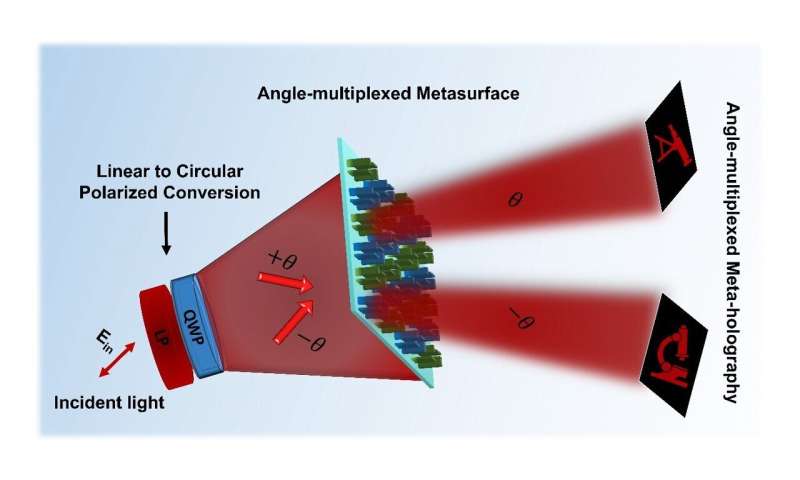This article has been reviewed according to Science X's editorial process and policies. Editors have highlighted the following attributes while ensuring the content's credibility:
fact-checked
peer-reviewed publication
trusted source
proofread
Angle-dependent holograms made possible by metasurfaces

Recently, a research team from Pohang University of Science and Technology (POSTECH) has employed metasurfaces to fabricate angle-dependent holograms with multiple functions. This technology allows holograms to display multiple images based on the observer's viewing angle. The findings were published in Nano Letters.
Objects can appear distinct depending on the viewer's position, a concept that can be harnessed in holographic technology to generate cinematic and realistic 3D holograms presenting different images based on the viewing angle. However, the current challenge lies in controlling light dispersion according to the angle, making the application of nano-optics in this context a complex endeavor.
The team addressed this challenge by leveraging metasurfaces, artificial nanostructures capable of precisely manipulating the characteristics of light. These metasurfaces are incredibly thin and lightweight, approximately one-hundredth the thickness of a human hair, making them promising for applications in miniaturized displays such as virtual and augmented reality devices.
Through the use of metasurfaces, the team devised a system that controls light to convey only a specific phase of information at a given angle, resulting in diverse images based on the angle of incidence.
In their experiments, the team's metasurface generated distinct 3D holographic images at angles of both +35° and -35° for left-circular polarization. Remarkably, the team achieved the production of different images for incident light by using a single metasurface, contingent on the specific polarization. Notably, the holographic display demonstrated an extensive viewing angle of 70° (±35°), enabling observers to perceive the three-dimensional hologram from various directions.
A research team comprising Professor Junsuk Rho from the Department of Mechanical Engineering and the Department of Chemical Engineering and Ph.D. candidate Joohoon Kim from the Department of Mechanical Engineering at the POSTECH created metasurface display technology.
Professor Junsuk Rho who led the research explained, "We have successfully achieved an effective display from diverse angles." He added, "We anticipate this technology will make significant contributions to the commercialization of technology in virtual and augmented reality displays, encrypted imaging, information storage, and other applications."
More information: Sabiha Latif et al, Spin-Selective Angular Dispersion Control in Dielectric Metasurfaces for Multichannel Meta-Holographic Displays, Nano Letters (2024). DOI: 10.1021/acs.nanolett.3c04064
Journal information: Nano Letters
Provided by Pohang University of Science and Technology





















